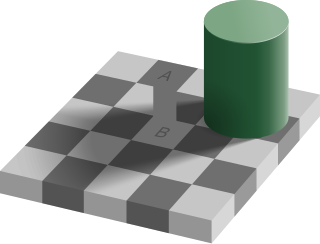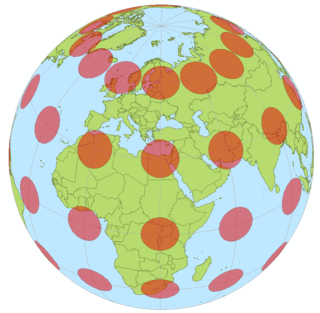A metapattern is a pattern of patterns.
A metapattern is a pattern of patterns.
The concept of a metapattern was introduced by Gregory Bateson in the introduction to his 1979 book Mind and Nature: A Necessary Unity. [1] "My central thesis can now be approached in words: The pattern which connects is a metapattern. It is a pattern of patterns. It is that metapattern which defines the vast generalization that, indeed, it is patterns which connect." [2]
Tyler Volk, an environmental scientist at New York University expanded on Bateson's description in his 1995 book, Metapatterns: Across Space, Time, and Mind. [3] "To me, a metapattern is a pattern so wide-flung that it appears throughout the spectrum of reality: in clouds, rivers, and planets; in cells, organisms, and ecosystems; in art, architecture, and politics." Volk further defines metapatterns as "functional universals for forms in space, processes in time, and concepts in mind." [4]
As Volk explains in his prologue, "I was fortunate to have studied with Bateson while he was writing Mind and Nature. It was the autumn of 1977, and he was a scholar-in-residence at the Lindisfarne Association in New York City." [5] At that time, Volk was teaching "Visual Science" and "Patterns in Time" as science and humanities courses at the School of Visual Arts.
Volk describes ten metapatterns: Spheres, Sheets/Tubes, Borders, Binaries, Centers, Layers, Calendars, Arrows, Breaks, and Cycles. Education collaborator Jeff Bloom developed a metapatterns website [6] exploring these themes.
The Dutch computer scientist Pieter Wisse proposed a method called Metapattern for conceptual modeling: a technique for meta-information analysis and modeling that emphasizes reusability. The method is described in his book Metapattern: Context and Time in Information Models [7] and other papers.

The philosophy of perception is concerned with the nature of perceptual experience and the status of perceptual data, in particular how they relate to beliefs about, or knowledge of, the world. Any explicit account of perception requires a commitment to one of a variety of ontological or metaphysical views. Philosophers distinguish internalist accounts, which assume that perceptions of objects, and knowledge or beliefs about them, are aspects of an individual's mind, and externalist accounts, which state that they constitute real aspects of the world external to the individual. The position of naïve realism—the 'everyday' impression of physical objects constituting what is perceived—is to some extent contradicted by the occurrence of perceptual illusions and hallucinations and the relativity of perceptual experience as well as certain insights in science. Realist conceptions include phenomenalism and direct and indirect realism. Anti-realist conceptions include idealism and skepticism. Recent philosophical work have expanded on the philosophical features of perception by going beyond the single paradigm of vision.
Systems theory is the interdisciplinary study of systems, i.e. cohesive groups of interrelated, interdependent components that can be natural or human-made. Every system has causal boundaries, is influenced by its context, defined by its structure, function and role, and expressed through its relations with other systems. A system is "more than the sum of its parts" by expressing synergy or emergent behavior.

Gregory Bateson was an English anthropologist, social scientist, linguist, visual anthropologist, semiotician, and cyberneticist whose work intersected that of many other fields. His writings include Steps to an Ecology of Mind (1972) and Mind and Nature (1979).
Cultural ecology is the study of human adaptations to social and physical environments. Human adaptation refers to both biological and cultural processes that enable a population to survive and reproduce within a given or changing environment. This may be carried out diachronically, or synchronically. The central argument is that the natural environment, in small scale or subsistence societies dependent in part upon it, is a major contributor to social organization and other human institutions. In the academic realm, when combined with study of political economy, the study of economies as polities, it becomes political ecology, another academic subfield. It also helps interrogate historical events like the Easter Island Syndrome.

The map–territory relation is the relationship between an object and a representation of that object, as in the relation between a geographical territory and a map of it. Polish-American scientist and philosopher Alfred Korzybski remarked that "the map is not the territory" and that "the word is not the thing", encapsulating his view that an abstraction derived from something, or a reaction to it, is not the thing itself. Korzybski held that many people do confuse maps with territories, that is, confuse conceptual models of reality with reality itself. These ideas are crucial to general semantics, a system Korzybski originated.
A double bind is a dilemma in communication in which an individual receives two or more reciprocally conflicting messages. In some scenarios this can be emotionally distressing, creating a situation in which a successful response to one message results in a failed response to the other, such that the person responding will automatically be perceived as in the wrong, no matter how they respond. This double bind prevents the person from either resolving the underlying dilemma or opting out of the situation.
The consciousness and binding problem is the problem of how objects, background and abstract or emotional features are combined into a single experience.

Nicholas Keynes Humphrey is an English neuropsychologist based in Cambridge, known for his work on evolution of primate intelligence and consciousness. He studied mountain gorillas with Dian Fossey in Rwanda; he was the first to demonstrate the existence of "blindsight" after brain damage in monkeys; he proposed the theory of the "social function of intellect". He is the only scientist to have edited the literary journal Granta.
Holonomic brain theory is a branch of neuroscience investigating the idea that human consciousness is formed by quantum effects in or between brain cells. Holonomic refers to representations in a Hilbert phase space defined by both spectral and space-time coordinates. Holonomic brain theory is opposed by traditional neuroscience, which investigates the brain's behavior by looking at patterns of neurons and the surrounding chemistry.
Systems philosophy is a discipline aimed at constructing a new philosophy by using systems concepts. The discipline was first described by Ervin Laszlo in his 1972 book Introduction to Systems Philosophy: Toward a New Paradigm of Contemporary Thought. It has been described as the "reorientation of thought and world view ensuing from the introduction of "systems" as a new scientific paradigm".

Steps to an Ecology of Mind is a collection of Gregory Bateson's short works over his long and varied career. Subject matter includes essays on anthropology, cybernetics, psychiatry, and epistemology. It was originally published by Chandler Publishing Company in 1972.

A visual language is a system of communication using visual elements. Speech as a means of communication cannot strictly be separated from the whole of human communicative activity which includes the visual and the term 'language' in relation to vision is an extension of its use to describe the perception, comprehension and production of visible signs.
J. A. Scott Kelso is an American neuroscientist, and Professor of Complex Systems and Brain Sciences, Professor of Psychology, Biological Sciences and Biomedical Science at Florida Atlantic University (FAU) in Boca Raton, Florida and The University of Ulster in Derry, N. Ireland.

Tyler Volk is a professor in the departments of environmental studies and biology at New York University.
In The Tree of Knowledge (1987:47), Humberto Maturana and Francisco Varela set out a way of describing the nature of living things: “… [An] organization denotes those relations that must exist among components of a system for it to be a member of a specific class. Structure denotes the components and relations that actually constitute a particular unity [or thing]…” While Maturana and Varela (1987:28) do not pursue a specific discussion about process, they set out to understand the role of cognition as “… the universal nature of doing”. Maturana and Varela are seeking to understand what they term autopoiesis, how living things self–produce. Maturana and Varela (1987:47) claim: “… by realizing what characterizes living beings in their autopoietic organization, we can unify a whole lot of empirical data about their biochemistry and cellular functioning”.

Information is an abstract concept that refers to that which has the power to inform. At the most fundamental level, information pertains to the interpretation of that which may be sensed, or their abstractions. Any natural process that is not completely random and any observable pattern in any medium can be said to convey some amount of information. Whereas digital signals and other data use discrete signs to convey information, other phenomena and artefacts such as analogue signals, poems, pictures, music or other sounds, and currents convey information in a more continuous form. Information is not knowledge itself, but the meaning that may be derived from a representation through interpretation.

Cybernetics is a wide-ranging field concerned with circular causal processes such as feedback. Norbert Wiener named the field after an example of circular causal feedback—that of steering a ship where the helmsman adjusts their steering in response to the effect it is observed as having, enabling a steady course to be maintained amongst disturbances such as cross-winds or the tide.
Systems theory in anthropology is an interdisciplinary, non-representative, non-referential, and non-Cartesian approach that brings together natural and social sciences to understand society in its complexity. The basic idea of a system theory in social science is to solve the classical problem of duality; mind-body, subject-object, form-content, signifier-signified, and structure-agency. System theory suggests that instead of creating closed categories into binaries (subject-object); the system should stay open so as to allow free flow of process and interactions. In this way the binaries are dissolved.
Ludwig Bertalanffy describes two types of systems: open systems and closed systems. The open systems that we know of are systems that allow interactions between their internal elements and the environment. An open system is defined as a “system in exchange of matter with its environment, presenting import and export, building-up and breaking-down of its material components.” Closed systems, on the other hand, are held to be isolated from their environment. Equilibrium thermodynamics, for example, is a field of study that applies to closed systems.
Meta-communication is a secondary communication about how a piece of information is meant to be interpreted. It is based on the idea that the same message accompanied by different meta-communication can mean something entirely different, including its opposite, as in irony. The term was brought to prominence by Gregory Bateson to refer to "communication about communication", which he expanded to: "all exchanged cues and propositions about (a) codification and (b) relationship between the communicators". Meta-communication may or may not be congruent, supportive or contradictory of that verbal communication.